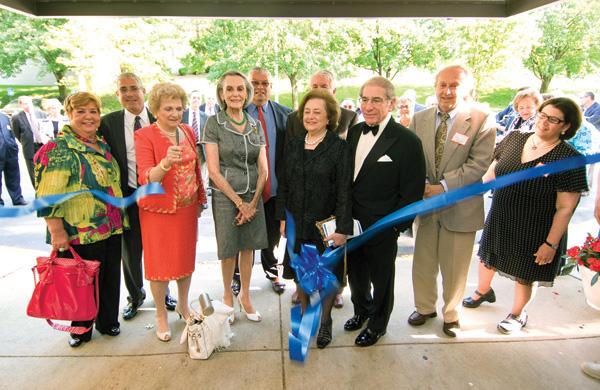Covenant House celebrates revamped units
Published May 20, 2010
If the bedroom in Unit D104 of Covenant House’s Building I looks comparable in size to the living area, there’s a reason for that. It used to be a living area – but one unfortunately in which no one was living. The constant vacancies plaguing the unit and other studio apartments just like it was a vexing problem executive director Janet Weinberg knew all too well.
The product of that dilemma was the creation of D104 and 14 similar apartments brought about by joining pairs of 30 single-room efficiency-style spaces and transforming them into more desirable one-bedroom, two-bath apartments. The less-is-more strategy was designed to increase the marketability of the smaller units, many of which had gone unoccupied for years.
The result?
“Out of the 15 new units like this, 10 are already committed to be rented by June 1,” said a smiling Weinberg.
That victory was among the reasons for a cocktail hour celebration last Tuesday night at the Millstone Campus facility where nearly 150 people gathered to honor donors and recognize Covenant/Chai’s continuing progress.
The Covenant I lobby was renamed after Celia Whidman, mother of Marilyn Fox. Fox attended the event with husband Sam, representing the Fox Family Foundation. The dining area was labeled the Royal Dining Room after donor Royal Bank, while the multipurpose room took on the title of the Milford and Lee Bohm Social Hall. The Mildred, Herbert and Julian Simon Foundation was also honored for its support and Covenant I was rededicated and given the additional moniker, the Harry and Jeanette Weinberg Building, to recognize support from the foundation of the same name. Meanwhile, the chapel, backed by funds from Helene Mirowitz, was named in honor of her and her husband Carl.
“It’s for all people, old and young,” said Helene Mirowitz, after the event. “I think a chapel is necessary. A lot of people can’t travel. People that wouldn’t go to a shul now have a shul to go to.”
The event was held to mark a number of happenings at Covenant, which has been in the midst of an ambitious and ongoing revamp for the past several years involving virtually all of the physical aspects of the institution. Most notably, it marks the culmination of a capital campaign that began in 2004 after then-property manager Jerry Nelson told Weinberg that many of the systems in Covenant I were reaching the end of their useful life and replacements would soon be needed.
In response, Weinberg went a step further and ordered a comprehensive architect’s report on all three buildings. The results found that about $8.5 million in repairs would be in the offing. The figures were sobering.
“We then said ‘How are we going to come up with this money?'” Weinberg recalled. “We’d never raised anything close to that.”
Management considered various refinancing and borrowing ideas but found such options posed significant risks. A study was commissioned which hit upon the solution – a $4.5 million capital campaign for Covenant I to be financed half by donations and half by rent increases on Section 8 units which were found to be let at under market value. Meanwhile, rent increases for the other buildings would raise money to take care of their issues. Total outlays for the project would run in the $8.5 million to $10 million range.
The strategy paid off. Since then, the facilities have undergone a large-scale revamp involving everything from new flooring, roofing and landscaping to painting, HVAC systems and window replacement. Among other things, brick ledges were sealed, sidewalks replaced and fire alarm systems upgraded, many countertops and sinks were replaced, electrical and plumbing repairs were made, some elevators were modernized and a number of boilers were updated to energy-efficient equipment. HD television antennas were installed. Various common areas were renovated and many apartment appliances and condensing units were changed out while a significant number of bathtubs were converted to showers to improve accessibility.
“You’ll notice that some things were done in certain buildings and not in others,” Weinberg said. “The Chai Building is a younger building. We’ve replaced the windows already in these two buildings but we want to replace them in that building.”
The windows are only part of the institution’s future plans for a facelift that is only about halfway done. This year, the agenda includes road repairs, trash compactor replacements, drainage issues and more appliance updates among other things. Weinberg expects the revamp could run until about 2014 or 2015.
“One big project this year is our wayfinding plan,” Weinberg said. “The signs are old and we tack up signs here and there so we are going to put together a unifying signage system in all three buildings.”
Meanwhile, Covenant is planning a May 26 open house from 12:30-6 p.m., to showcase the newly created 868-square foot, one-bedroom units. Weinberg admits it wasn’t an easy process getting there. Completed in 1973, the building originally contained mostly studio units. As demand for those lagged in the 1990s, about one-third were converted to one-bedrooms. Even so, more than 50 of the existing 94 remained unused causing the building to operate at a deficit.
Donor Lee Bohm has her own take on Covenant’s situation – and the role it plays in St. Louis’s Jewish life.
“One of the reasons why I’ve been involved with Covenant House for many years is that I have a strong belief that the youngest and the oldest in our community are the ones that really need to be taken care of,” said Bohm, interviewed after the event. “That’s why I feel very strongly about this, because I really feel that children and seniors are vulnerable.”















